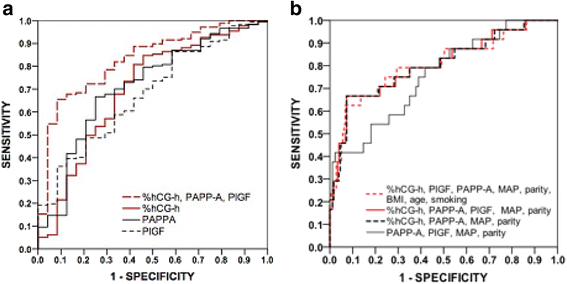First trimester serum placental growth factor and hyperglycosylated human chorionic gonadotropin are associated with pre-eclampsia: a case control study
- PMID: 27887594
- PMCID: PMC5124279
- DOI: 10.1186/s12884-016-1169-4
First trimester serum placental growth factor and hyperglycosylated human chorionic gonadotropin are associated with pre-eclampsia: a case control study
Abstract
Background: To study whether maternal serum hyperglycosylated human chorionic gonadotropin (hCG-h) improves first trimester prediction of pre-eclampsia when combined with placental growth factor (PlGF), pregnancy-associated plasma protein-A (PAPP-A) and maternal risk factors.
Methods: Gestational-age-adjusted concentrations of hCG, hCG-h, PlGF and PAPP-A were analysed in serum samples by time-resolved immunofluorometric assays at 8-13 weeks of gestation. The case-control study included 98 women who developed pre-eclampsia, 25 who developed gestational hypertension, 41 normotensive women with small-for-gestational-age (SGA) infants and 177 controls.
Results: Of 98 women with pre-eclampsia, 24 women developed preterm pre-eclampsia (diagnosis < 37 weeks of gestation) and 13 of them had early-onset pre-eclampsia (diagnosis < 34 weeks of gestation). They had lower concentrations of PlGF, PAPP-A and proportion of hCG-h to hCG (%hCG-h) than controls. In receiver-operating characteristics (ROC) curve analysis, the area under the curve (AUC) for the combination of PlGF, PAPP-A, %hCG-h, nulliparity and mean arterial blood pressure was 0.805 (95% confidence interval, CI, 0.699-0.912) for preterm pre-eclampsia and 0.870 (95% CI 0.750-0.988) for early-onset pre-eclampsia. Without %hCG-h the AUC values were 0.756 (95% CI 0.651-0.861) and 0.810 (95% CI 0.682-0.938) respectively. For prediction of gestational hypertension, the AUC for %hCG-h was 0.708 (95% CI 0.608-0.808), but for other markers the AUC values were not significant. None of the AUC values were significant for the prediction of SGA infants in normotensive women.
Conclusions: First trimester maternal serum %hCG-h tended to improve prediction of preterm and early-onset pre-eclampsia when combined with PlGF, PAPP-A and maternal risk factors.
Keywords: Gestational hypertension; Hyperglycosylated human chorionic gonadotropin; Placental growth factor; Pre-eclampsia; Pregnancy-associated plasma protein-A; Small-for-gestational-age.
Figures



Similar articles
-
Prediction of pre-eclampsia and its subtypes in high-risk cohort: hyperglycosylated human chorionic gonadotropin in multivariate models.BMC Pregnancy Childbirth. 2018 Jul 3;18(1):279. doi: 10.1186/s12884-018-1908-9. BMC Pregnancy Childbirth. 2018. PMID: 29970026 Free PMC article. Clinical Trial.
-
First trimester hyperglycosylated human chorionic gonadotrophin in serum - a marker of early-onset preeclampsia.Placenta. 2013 Nov;34(11):1059-65. doi: 10.1016/j.placenta.2013.08.006. Epub 2013 Aug 28. Placenta. 2013. PMID: 23993394
-
Routine first-trimester combined screening for pre-eclampsia: pregnancy-associated plasma protein-A or placental growth factor?Ultrasound Obstet Gynecol. 2021 Oct;58(4):540-545. doi: 10.1002/uog.23669. Epub 2021 Sep 13. Ultrasound Obstet Gynecol. 2021. PMID: 33998078
-
Serum screening in first trimester to predict pre-eclampsia, small for gestational age and preterm delivery: systematic review and meta-analysis.BMC Pregnancy Childbirth. 2015 Aug 25;15:191. doi: 10.1186/s12884-015-0608-y. BMC Pregnancy Childbirth. 2015. PMID: 26303460 Free PMC article.
-
Obstetrical complications associated with abnormal maternal serum markers analytes.J Obstet Gynaecol Can. 2008 Oct;30(10):918-932. doi: 10.1016/S1701-2163(16)32973-5. J Obstet Gynaecol Can. 2008. PMID: 19038077 Review. English, French.
Cited by
-
Modified multiple marker aneuploidy screening as a primary screening test for preeclampsia.BMC Pregnancy Childbirth. 2022 Mar 8;22(1):190. doi: 10.1186/s12884-022-04514-4. BMC Pregnancy Childbirth. 2022. PMID: 35260099 Free PMC article.
-
Predictive Performance of Machine Learning-Based Methods for the Prediction of Preeclampsia-A Prospective Study.J Clin Med. 2023 Jan 4;12(2):418. doi: 10.3390/jcm12020418. J Clin Med. 2023. PMID: 36675347 Free PMC article.
-
Altered level of salivary placental growth factor is associated with preeclampsia.Placenta. 2020 Jan 15;90:118-120. doi: 10.1016/j.placenta.2019.12.016. Epub 2019 Dec 23. Placenta. 2020. PMID: 32056542 Free PMC article.
-
The Relationship of Pregnancy-Associated Plasma Protein A and Human Chorionic Gonadotropin with Adverse Pregnancy Outcomes: A Prospective Study.J Obstet Gynaecol India. 2019 Oct;69(5):412-419. doi: 10.1007/s13224-019-01217-3. Epub 2019 Apr 11. J Obstet Gynaecol India. 2019. PMID: 31598043 Free PMC article.
-
Recent advances in understanding gonadotropin signaling.Fac Rev. 2021 Apr 19;10:41. doi: 10.12703/r/10-41. eCollection 2021. Fac Rev. 2021. PMID: 34046645 Free PMC article. Review.
References
-
- Roberge S, Giguere Y, Villa P, Nicolaides K, Vainio M, Forest JC, et al. Early administration of low-dose aspirin for the prevention of severe and mild preeclampsia: a systematic review and meta-analysis. Am J Perinatol. 2012;29:551–6. - PubMed
Publication types
MeSH terms
Substances
LinkOut - more resources
Full Text Sources
Other Literature Sources
Miscellaneous

